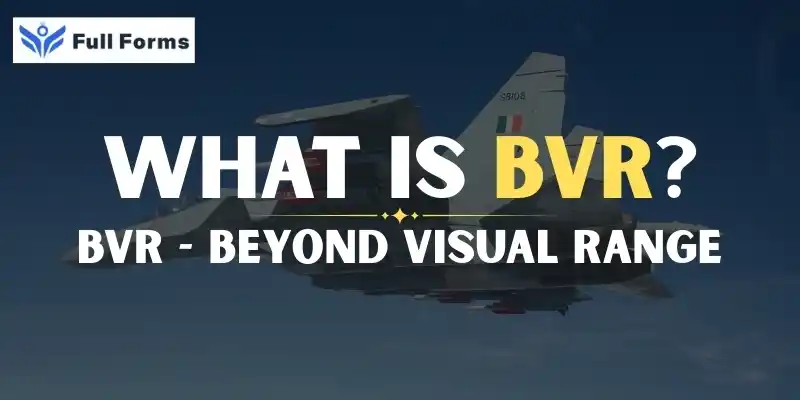Beyond Visual Range
(BVR)

Description
Technology has changed the nature of aerial combat. Perhaps the most important is the use of beyond visual range (BVR) systems, which allow fighter aircraft to find, track, and attack targets much farther beyond the range of human vision. In simple words, one does not have to get a direct visual on the enemy to kill him.
What is meant by "Beyond Visual Range”
“Beyond Visual Range” (BVR) is referred to as the ability to do something, particularly attack from a distance beyond that at which one can see with the naked eye. This may refer in air combat to missiles or radar systems able to detect and shoot down enemy aircraft from tens or even hundreds of kilometers away.
There was the old-fashioned way of dogfighting: a pilot had to visually acquire the adversary at close range and then arm his aircraft’s guns or short-range missiles. However, BVR technology has changed everything. A pilot can now remotely lock on to a target and launch a missile that navigates itself to the enemy aircraft. The enemy does not even know when they are being targeted.
Many advanced technologies have to collaborate for BVR to function. These are the most critical ones:
Radar Systems
The aircraft would be equipped with powerful radars that could detect hostile aircraft from long ranges, beyond 100 kilometers.
Missiles
BVR missiles can hit targets being launched from a far distance. On being launched, they change direction in the air by GPS, infrared, or radar.
Targeting Systems
Such systems enable the pilot to find and lock onto a target, whether in motion or attempting to hide.
Electronic Warfare Support
Electronic support for BVR includes jamming enemy signals, radar warning receiver modes, and the capability to present countermeasure solutions to threats.
What Makes BVR So Important?
Safety for the pilots:
The pilots are not very likely to be shot down because they did not approach the bad guys. It is more probable that you live.
Fast reaction:
BVR will allow the troops to react fast and before the enemy brings anything into their picture.
Extended reach:
BVR-equipped aircraft can cover more ground, enhancing their utility for the defense of national airspace or long-range patrols.
Requirement of Modern Warfare:
It is imperative in modern, high-tech military operations to be timely; that is, to take timely and wise actions; and BVR facilitates exactly that.
BVR Systems in Practice
Many countries have developed BVR missiles and systems. Some of the most well-known include:
AIM-120 AMRAAM (USA): A BVR missile much in use and in whom the US and its allies repose a lot of faith. Ranges between 100 to 180 km.
Meteor (Europe): Meteor is one of the most advanced BVR missiles in the world, originating from the European consortium.
DRDO of India: has developed an Astra BVR missile to strengthen the Indian Air Force. This travels about 80-110 km.
PL-15(China): A long-range missile termed to be of more than 200km. Hence, a great defense for China in air.
Usage of BVR by Pilots in Combat
Real-life application is not a push-button affair. Pilots must receive the appropriate training and be quick thinkers. They have to decide whether a target is legitimately hostile, determine the optimum angle for missile launch, and factor in other variables. This can be weather, terrain, and the enemy’s countermeasures that will affect BVR performance.
Modern fighter jets like Rafale, F-22 Raptor, Sukhoi Su-30, JAS 39 Gripen, and Eurofighter Typhoon are capable of engaging Beyond Visual Range (BVR); the effective operation of which necessitates the application of voice commands, cockpit displays, and cutting-edge computers for BVR missions.
The Limitations of BVR Combat … but BVR isn’t perfect:
Bogey Dope:
Sometimes radar gets “bogies” and it thinks they’re bad guys or even other friendly aircraft.
Electronic Jamming:
Any enemy may had jumbled the information up with the missile or jumbled the radar signal.
Rules of Engagement:
Pilots at times have to visually identify a target before firing to avoid mishaps or hitting friendly civilian aircraft.
What is the Future of BVR
As military technology advances, so will BVR systems. Future developments shall include:
- Missiles controlled by AI that can take decisions and accurately determine the best way to go.
- Technology making enemy radar screen airplanes as invisible
- Data fusion between sharing data among aircraft, UAVs, ground stations - better targeting.
- BVR systems are also anticipated for drones and other UAVs, which would make air combat safe and smart.
The The advent of Beyond Visual Range technology has certainly brought a change in the operational methodology of air combat. Earlier, one needed to be brave and eagle-eyed to engage close combat dogfighting; now, it is more about being smart, planned, and well-equipped. These BVR systems tend to be safe for a nation’s defense and for a pilot since they have an extended range, are secured, and smart targeting.
The sky is turning into an arena of intelligence as well as bravery as air forces worldwide keep deploying and enhancing BVR capabilities.
